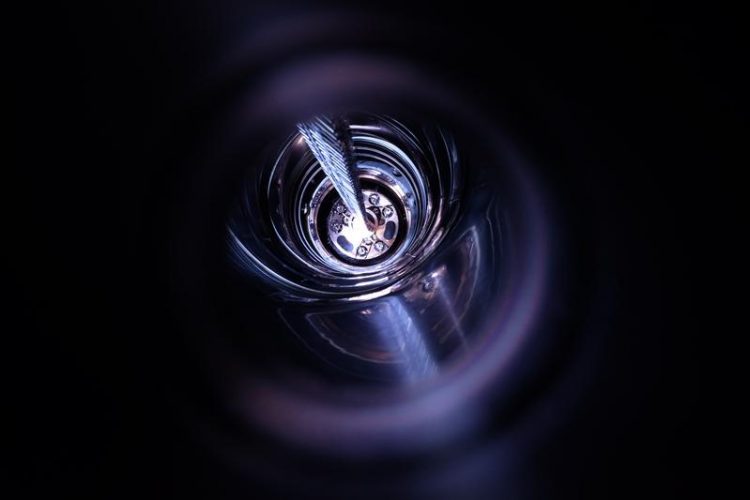The GERDA Experiment ready to discover rarest radioactive decay

Preparation of the GERDA experiment: Lowering the germanium detector array into the liquid argon tank - view from top. M. Heisel/GERDA collaboration
Neutrinos are ghostly particles which are extremely hard to detect. They play a central role in how the sun burns, how supernovae explode and how elements are formed during the big bang. Determining their properties has advanced our understanding of elementary particles considerably, best documented by the fact that so far four Nobel prizes have been awarded to neutrino related research.
One fundamental property is still unknown: are neutrinos Majorana particles, i.e. identical to their own anti-particles? In that case 0νββ decay will exist. Strong theoretical arguments favor this possibility and the above mentioned absence of anti-matter in our universe is likely connected to the Majorana character of neutrinos.
“Normal” double beta decay is an allowed rare process where two neutrons in a nucleus decay simultaneously into two protons, two electrons and two anti-neutrinos. It has been observed for some nuclei like 76Ge, where single beta decay is not possible. The electrons and anti-neutrinos leave the nucleus, only the electrons can be detected. In 0νββ decay, no neutrinos leave the nucleus and the sum of the energies of the electrons is identical to the well known energy release of the decay. Measurement of exactly this energy is the prime signature for 0νββ decay.
Because of the importance of 0νββ decay in revealing the character of neutrinos and new physics, there are about a dozen experiments worldwide using different techniques and isotopes. The GERDA experiment is one of the leading experiments in the field, conducted by a European Collaboration. It is located in the underground Laboratori Nazionali del Gran Sasso of the Italian research organization INFN.
GERDA uses high-purity germanium detectors enriched in the isotope 76Ge. Since the germanium is source and detector at the same time, a compact setup with minimum additional materials can be realized leading to low backgrounds and high detection efficiency. The excellent energy resolution of germanium detectors and the novel experimental techniques developed by the GERDA collaboration provide unprecedented suppression of disturbing events from other radioactive decays (background events). Since 0νββ decay has a half-live many orders of magnitude longer than the age of the universe, the reduction of background events is most crucial for the sensitivity.
The bare germanium detectors are operated in 64 m3 of liquid argon at a temperature of -190 degree Celsius. The argon container itself is inside a 590 m3 tank filled with pure water which in turn is shielded by the Gran Sasso mountain against cosmic rays. The used argon and water are extremely pure in uranium and thorium; the liquids act as further shield for natural radioactivity from the surrounding. Their instrumentation provides additional means of background identification.
The novel techniques employed by GERDA reduced the number of background events in such a way, that now it is the first “background-free” experiment in the field. No 0νββ decays have been observed during the first five months of data taking and a lower half-life limit of 5×1025 yr was derived. Until the end of data taking in 2019 no background event should be left in the energy region where the 0νββ signal is expected and a sensitivity of 1026 yr will be reached. This makes GERDA best suited to discover a signal, which would manifest itself by a small number of events at the signal energy.
GERDA is an international European collaboration of more than 100 physicists from Germany, Italy, Russia, Switzerland, Poland and Belgium (http://www.mpi-hd.mpg.de/gerda/).
In Germany the following institutes are involved: Technische Universität Dresden, Max Planck Institute for Nuclear Physics, Max Planck Institute for Physics, Technical University of Munich, Eberhard Karls Universität Tübingen.
Data and Pictures:
https://www.mpi-hd.mpg.de/gerda/public/index.html
Original publication:
GERDA Collaboration: Background-free search for neutrinoless double-b decay of 76-Ge with GERDA; Nature, 06 April 2017
DOI: 10.1038/nature21717
Contact:
Prof. Dr. Kai Zuber
Institut für Kern- und Teilchenphysik
Technische Universität Dresden
E-Mail: zuber@physik.tu-dresden.de
Tel.: +49 351 463 42250
Dr. Bernhard Schwingenheuer
GERDA Speaker
Max Planck Institute for Nuclear Physics (MPIK), Heidelberg
E-Mail: bernhard.schwingenheuer@mpi-hd.mpg.de
Tel.: +49 6221 516 614
Dr. Bela Majorovits
Max Planck Institute for Physics, Munich
E-Mail: bela@mpp.mpg.de
Tel.: +49 89 323 54 262
Prof. Dr. Stefan Schönert
GERDA Co-Speaker
Physics Department and Exzellence Cluster Universe
Technical University of Munich
E-Mail: schoenert@ph.tum.de
Tel.: +49 89 289 12511
Prof. Dr. Josef Jochum
Physikalisches Institut
Eberhard Karls Universität Tübingen
E-Mail: Josef.Jochum@uni-tuebingen.de
Tel.: +49 7071 29 74453
Weitere Informationen:
https://www.mpi-hd.mpg.de/gerda/public/index.html
http://www.mpi-hd.mpg.de/gerda/
Media Contact
All latest news from the category: Physics and Astronomy
This area deals with the fundamental laws and building blocks of nature and how they interact, the properties and the behavior of matter, and research into space and time and their structures.
innovations-report provides in-depth reports and articles on subjects such as astrophysics, laser technologies, nuclear, quantum, particle and solid-state physics, nanotechnologies, planetary research and findings (Mars, Venus) and developments related to the Hubble Telescope.
Newest articles

A ‘language’ for ML models to predict nanopore properties
A large number of 2D materials like graphene can have nanopores – small holes formed by missing atoms through which foreign substances can pass. The properties of these nanopores dictate many…

Clinically validated, wearable ultrasound patch
… for continuous blood pressure monitoring. A team of researchers at the University of California San Diego has developed a new and improved wearable ultrasound patch for continuous and noninvasive…

A new puzzle piece for string theory research
Dr. Ksenia Fedosova from the Cluster of Excellence Mathematics Münster, along with an international research team, has proven a conjecture in string theory that physicists had proposed regarding certain equations….



